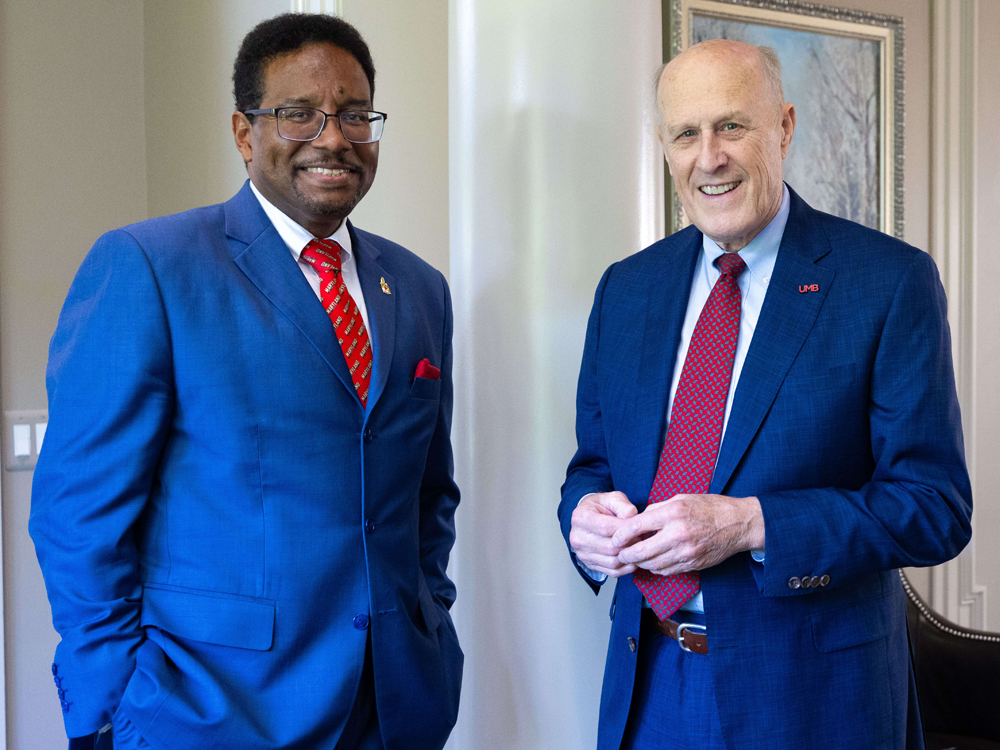Watch Video of ‘Virtual Face to Face’: Facing the Future Together
July 02, 2025 Alex Likowski
In this episode, UMB President Bruce Jarrell and UMCP President Darryll Pines discussed the wide array of challenges facing higher education and their teamwork approach.
“Rather than jumping over someone to get what you want, consider reaching out your hand and taking the leap side by side, because life is better when we leap together.” Kermit the Frog’s message to University of Maryland, College Park (UMCP) grads last month could not have been more timely, not just for grads getting ready to leap into society, but also their universities, which face a truly unprecedented array of challenges. Research, diversity and inclusion, international students, student finance — all now face the prospect of dramatic change under federal government policy.
Six months ago, everything was coming up roses for our universities at College Park and in Baltimore. “Our university gives us so many reasons to be proud,” wrote UMCP President Darryll J. Pines, PhD, MS. “Internationally ranked academic programs. Amazing artists and groundbreaking researchers. Award-winning faculty. Extraordinary and caring staff. Together, we are channeling our collective excellence to take on the grand challenges of our time.”
Even in light of the many challenges imposed by the federal government over the last several months, that’s all still happening, and in a big way. Topping the list at Maryland’s flagship university right now are two very big ideas that are increasingly connected: Quantum and AI.
Just over a year ago, UMCP launched the Artificial Intelligence Interdisciplinary Institute at Maryland — or AIM — offering teaching, learning, and innovation opportunities, building on over 100 faculty members who teach AI. At a recent meeting, Pines told Lt. Gov. Aruna Miller and leaders from chip maker NVIDIA, when it comes to AI, he’s “all in.”
And then there’s quantum. We’re not talking about Planck’s Constant or Heisenberg’s Uncertainty Principle. That’s quantum mechanics and soooo last century. No, today’s quantum is being called a seismic shift in computing. Where our computers today use electrical signals to create “ones” and “zeros” to represent data, quantum computing uses quantum bits, subatomic particles that exhibit very peculiar particle and wave characteristics. As a result, quantum computing may be able to tackle far more complex problems, like modeling complex biochemical reactions, and revolutionize everything from meteorology to metals science.
In April, Maryland Gov. Wes Moore and leaders from the Defense Advanced Research Projects Agency joined Pines to create the Capital Quantum Benchmarking Hub, a cooperative effort dedicated to testing and evaluating quantum computing prototypes and systems for national security and commercial applications, based in College Park.
There are also big collaborations taking place between the University of Maryland, Baltimore (UMB) and UMCP. Many, but not all, are part of the University of Maryland Strategic Partnership: MPowering the State (MPower). MPower’s founding idea is for researchers from different disciplines at UMB and UMCP to link up and collaborate to tackle challenges neither one could do alone. And of course, for the last several years, the two universities have even coordinated and reported research activities as one. Together, the University of Maryland now ranks 18th among all U.S. institutions in research expenditures, and 11th among public institutions. The last report, for fiscal year 2023, shows $1.4 billion in research spending, an increase of $157 million from the previous year.